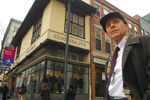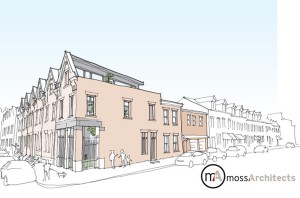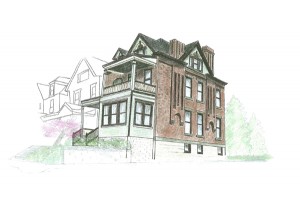
Archive: Wed Feb 2011
-
Row of Vacant Lawrenceville Houses Being Restored with Historic Exteriors, Custom Interiors
Wednesday, February 02, 2011
Pop City Media
Since they were left vacant in 1995, the row of five historic brick houses on 48th Street, between Hatfield and Butler Streets, in Lawrenceville have fallen into terrible shape. With creative design and green construction, the homes are being restored to look the way they would have when they were built in the 19th century, but with customized modern interiors.
The City of Pittsburgh acquired the buildings, with the help of the Lawrenceville Corporation, in 2007 at very low cost using a tax lien process. After receiving proposals from many eager developers, the Lawrenceville Corporation closed on the sale last week with Botero Development, who’s principal Brian Mendelssohn lives in the neighborhood.
“They’re going to be a high quality product. We’re going to restore the exteriors using real materials, meaning real stone and real slate, and install stone steps and things like that to make them look like when they were built,” says Mendelssohn, who is working with Moss Architects on the project. The interiors will be custom-built for the aesthetic whims of the individual buyers, blending historic elements and original materials with modern features, such as stainless steel appliances, and energy efficient design aspects, like a 2-inch white rubber roof.
The homes, which are currently for sale, include four 1900-square-foot, 3-bedroom units with rear yards. Two come with 2.5-baths and the other two have 2-baths. One 1,250-square-foot unit has 2-bedrooms and 2-baths. The houses will be completed by next October and are priced between $180,000 and $265,000. A sixth building was beyond repair, but its lot will serve as a private courtyard for the $265,000 unit.
“I feel the prices are below market value for what these buildings are,” says Mendelssohn. “It will be good for the neighborhood not to start charging $300,000 for homes in Lawrenceville. You don’t want to gentrify your own neighborhood, you want to keep it what it is.”
Writer: John Farley
Source: Brian MendelssohnImage courtesy of Botero Development
-
$10 Million PHLF Redevelopment Projects Restore Three Homes and Create 27 Apartments in Wilkinsburg
Wednesday, February 02, 2011
Pop City Media
When Pop City last reported on The Pittsburgh History and Landmarks Foundation‘s Wilkinsburg redevelopment projects in 2008, four homes in the Hamnett Place neighborhood had successfully been restored. The PHLF recently announced that three more historic Hamnett Place houses, as well as the two-building, 27-unit Crescent Apartment development, are scheduled for completion by fall of 2011.
“It really is one big project because all of these things are kind of interlinked. We also launched a housing resource center in the same area last year and we’ve done a lot of cleaning and vacant lot work around the area. There are a lot of initiatives happening right now in Wilkinsburg that total over $10 million,” says Michael Sriprasert, director of real estate for the PHLF.
“Right now the three properties at 833 and 845 Holland Avenue and 517 Jeanette Street have undergone interior demolition and we have begun construction,” says David Farkas, director of main street programs for the PHLF, in regard to the second phase of the Hamnett Place project that began in December. The PHLF received assistance from Allegheny County Economic Development and The Allegheny Foundation for the restoration of these homes, which will have buyer incomes restricted to 120% of the area median income.
The PHLF is 30% finished with the redevelopment of two buildings in the $8.6 million, 27-unit affordable Crescent Apartments, which was funded by The Pennsylvania Housing Finance Agency, Allegheny County’s Office of Behavioral Health, and private sources.
The PHLF worked with architects Landmarks Design Associates on both the Hamnett Place and Crescent Apartments projects, and with Mistick Construction and Sota Construction on the Hamnett Place and Crescent Apartments, respectively.
Writer: John Farley
Sources: Michael Sriprasert and David Farkas, PHLFImage courtesy of PHLF
-
Landmarks Foundation Waits for Word on $4 Million State Grant
By Craig Smith
PITTSBURGH TRIBUNE-REVIEW
Wednesday, February 2, 2011
Arthur Ziegler, president of the Pittsburgh History & Landmarks Foundation, surveys Fifth Avenue, Downtown, part of an area his group has earmarked for more redevelopment like its Market at Fifth project. The foundation is awaiting word on whether a $4 million state grant from former Gov. Ed Rendell's administration will come through. Gov. Tom Corbett is reviewing that grant and others like it. Keith Hodan | Tribune-Review
Arthur Ziegler Jr. likes what he sees Downtown.
Seven apartments and two retailers occupy three historic buildings that were brought back to life through a $3 million Pittsburgh History & Landmarks Foundation project dubbed Market at Fifth. More projects in the area could come to fruition if a $4 million state grant comes through.
“I am very pleased … the momentum is gaining,” said Ziegler, the foundation’s president.
Ziegler hopes to leverage the $4 million grant from former Gov. Ed Rendell to do more historic renovation work. Gov. Tom Corbett, who took office last month, is reviewing the grants, handed out in the final days of the Rendell administration through the state’s Redevelopment Assistance Capital Program, or RCAP.
The money was committed to Pittsburgh for historic building facade and core shell restoration, Ziegler said. The city appointed the landmarks foundation to carry out the work.
“It would be a great project for the city and Downtown,” said Rob Stephany, executive director of the city Urban Redevelopment Authority.
Some leaders criticized Rendell’s use of the RCAP grants, which come from borrowed money. Corbett said before he took office he would review all of the grants Rendell approved at the end of his term.
“We’re trying to go through the RCAPs as quickly as possible to make a decision,” said Kevin Harley, spokesman for Corbett.
Other areas of the country are successfully using historic renovation to spur development.
“We’re seeing a real move back to our center city — businesses and residents,” said Kevin Schwab, vice president of communications for CenterState Corp. for Economic Opportunity in Syracuse, N.Y.
Since the late 1980s, the downtown population has doubled from 1,000 to 2,000 people and 16 of 18 condos near a historic district have been sold, Schwab said. In the past decade, the revitalization has gained momentum, even during the recession, he added.
“It has all been driven by the rehabilitation of buildings that have been deemed historic,” he said.
New buildings are going up “with an eye toward being in concert” with what is already around them, he said.
If the $4 million grant for Pittsburgh survives Corbett’s review, the landmarks foundation plans to augment it with donated funds “so we can really solidify the new quality retailing we introduced with Market at Fifth,” Ziegler said.
“We would like to double (the $4 million),” he said.
The money would be used to renovate a half-dozen historic buildings scattered in the Fifth and Forbes area that have been scheduled for preservation since the days of former Mayor Tom Murphy, Ziegler said.
The Market at Fifth project restored three buildings within the Market Square historic district, including the former Regal Shoe Co., which opened in 1908.
The Regal building was designed by Alden & Harlow, then one of the city’s prominent architectural firms, responsible for the Carnegie Institute and Library additions in Oakland, and Carnegie branch libraries in various communities.
Its chief designer was one of the firm’s principals, Frank E. Alden, who in the late 1800s worked with architect H.H. Richardson supervising construction of noteworthy Downtown buildings such as the Allegheny County Courthouse and the Allegheny County Jail.


